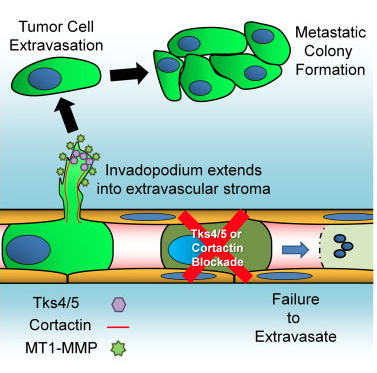Inhibition of invadopodia on tumor cells blocks extravasation and metastasis
A new study has shed light on tentacle-like structures called "invadopodia" in cancer metastasis. Genetic and pharmacological inhibition of invadopodia entirely blocked cancer spread by stopping extravasation at endothelial junctions.
Graphical abstract for the publication: Invadopodia Are Required for Cancer Cell Extravasation and Are a Therapeutic Target for Metastasis, by Leong et, Cell Reports, 2014.
Article summary:
Tumor cell extravasation is a key step during cancer metastasis, yet the precise mechanisms that regulate this dynamic process are unclear. We utilized a high-resolution time-lapse intravital imaging approach to visualize the dynamics of cancer cell extravasation in vivo. During intravascular migration, cancer cells form protrusive structures identified as invadopodia by their enrichment of MT1-MMP, cortactin, Tks4, and importantly Tks5, which localizes exclusively to invadopodia. Cancer cells extend invadopodia through the endothelium into the extravascular stroma prior to their extravasation at endothelial junctions. Genetic or pharmacological inhibition of invadopodia initiation (cortactin), maturation (Tks5), or function (Tks4) resulted in an abrogation of cancer cell extravasation and metastatic colony formation in an experimental mouse lung metastasis model. This provides direct evidence of a functional role for invadopodia during cancer cell extravasation and distant metastasis and reveals an opportunity for therapeutic intervention in this clinically important process.
Article link: http://www.cell.com/cell-reports/abstract/S2211-1247(14)00634-2?_returnURL=http%3A%2%2Flinkinghub.elsevier.com%2Fretrieve%2Fpii%2FS2211124714006342%3Fshowall%3Dtrue
Contact
Radmile Matejčić 2
51000 Rijeka
Croatia
Tel. +385 51 584 550
ured@biotech.uniri.hr
OIB (VAT): 64218323816
IBAN: HR3724020061400006958
Radmile Matejčić 2, O-047
http://studentska.uniri.hr/
Biotechnology for the Life Sciences e-mail :














